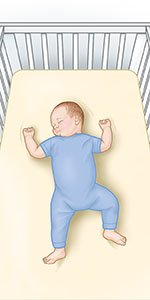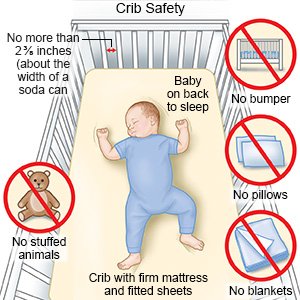Safe Sleeping for Infants
Medically reviewed by Drugs.com. Last updated on Aug 4, 2025.
Why is safe sleeping important for infants?
Babies should be placed in safe surroundings to decrease the risk of accidental death. Death from suffocation, strangulation, or sudden infant death syndrome (SIDS) can occur in certain sleeping situations. You can help keep your baby safe by learning how to safely put your baby to sleep. Share this information with grandparents, babysitters, and anyone else who cares for your baby.
How should I put my baby down to sleep?
- Put your baby on his or her back to sleep. Do this every time your baby sleeps (naps and at night) until he or she reaches 1 year of age. Do this even if your baby sleeps more soundly on his or her stomach or side.

- Check your baby's position. Turn your baby if he or she rolls from back to stomach and cannot roll stomach to back. You do not need to turn your baby if he or she is able to roll both ways.
- Put your baby on a firm, flat surface to sleep. Your baby should sleep in a crib, bassinet, or play yard that meets the Consumer Product Safety Commission (CPSC) safety standards. Make sure the slats of a crib are no wider than 2⅜ inches and that there are no drop-side rails. Do not let your baby sleep on pillows, waterbeds, soft mattresses, quilts, beanbags, or other soft surfaces. Never let him or her sleep on a couch or recliner. Move your baby to his or her bed if he or she falls asleep in a car seat, stroller, or swing. Your baby may change positions in a sitting device and not be able to breathe well.

- Put your baby in his or her own bed. A crib or bassinet in your room, near your bed, is the safest place for your baby to sleep. Never let your baby sleep in bed with you. Experts recommend that you have your baby sleep in your room for his or her first 6 months of life. This will help decrease the risk of SIDS. It will also make it easier for you to feed and comfort your baby.
- Do not leave soft objects or loose bedding in your baby's crib. His or her bed should contain only a firm mattress covered with a fitted bottom sheet. Use a sheet that is made for the mattress and fits tightly. Do not put pillows, bumpers, or stuffed animals in his or her bed. Do not use a blanket or comforter.
- Do not let your baby get too hot. Keep the room at a temperature that is comfortable for an adult. Never dress your baby in more than 1 layer more than you would wear. Dress your baby in a sleep sack or other sleep clothing before you put him or her down to sleep. Do not cover your baby's face or head while he or she sleeps. Your baby is too hot if he or she is sweating or his or her chest feels hot.
- Do not raise the head of your baby's bed. Your baby could slide or roll into a position that makes it hard for him or her to breathe.
What else can I do to decrease the risk for SIDS?
- Feed your baby breast milk. Experts recommend that you feed your baby only breast milk until he or she is 6 months old. Always put your baby back in his or her own bed after you feed him or her at night.
- Give your baby a pacifier when you put him or her down to sleep. Do not put it back in his or her mouth if it falls out after he or she is asleep. Do not attach the pacifier to a string. If your baby rejects the pacifier, do not force him or her to take it. If your baby breastfeeds, wait until he or she is breastfeeding well or is 1 month old before you offer a pacifier.
- Do not smoke or allow others to smoke around your baby. Also do not let anyone smoke in your home or car. Smoke gets into furniture and clothing. This causes your baby to breathe in smoke. Smoke increases the risk for SIDS.
- Do not buy products that claim to reduce the risk of SIDS. Examples are sleep wedges and sleep positioners. There is no evidence that these products are safe.
When should I call my baby's pediatrician?
- You have questions or concerns about how to safely put your baby to sleep.
Care Agreement
You have the right to help plan your baby's care. Learn about your baby's health condition and how it may be treated. Discuss treatment options with your baby's healthcare providers to decide what care you want for your baby. The above information is an educational aid only. It is not intended as medical advice for individual conditions or treatments. Talk to your doctor, nurse or pharmacist before following any medical regimen to see if it is safe and effective for you.© Copyright Merative 2025 Information is for End User's use only and may not be sold, redistributed or otherwise used for commercial purposes.
Further information
Always consult your healthcare provider to ensure the information displayed on this page applies to your personal circumstances.
